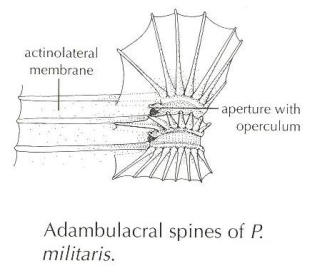Pteraster militaris is a stubby-armed, pale yellow sea star with a wrinkled aboral surface bearing a large pore (osculum) in the centre. Its colour can vary from creamy white to yellow or pink. Its five arms can grow up to 7.5 cm long. The ratio of arm to disc is 2.0 to 2.5. The aboral surface is a soft, fleshy, wrinkled, supradorsal membrane covering the aboral pseudopaxillae, which consist of a low base, slightly higher than it is wide, with 3 to 5 slender spinelets radiating from the top. Under magnification, tiny calcareous bodies can be seen in the membrane but no muscle bands as in Diplopteraster multipes. The adambulacrals of P. militaris have a transverse webbed comb of 6 to 9 spines, the proximal spine being the smallest. Extending horizontally from the outer end of the plate is a large spine (about three times length of the plate) embedded in the actinolateral membrane. The free outer edge of this membrane almost delineates the edge of the arm when viewed from the aboral side. Each mouth plate has 6 to 8 slender marginal spines joined by a membrane. A single large glassy-tipped suboral spine stands near the suture on each plate.
Characteristics
Similar SpeciesPteraster militaris has longer arms and a softer, more wrinkled skin than its close relative, Pteraster tesselatus. The fans of marginal spines on adjoining mouth plates are not joined together by a continuous membrane as in P. tesse
